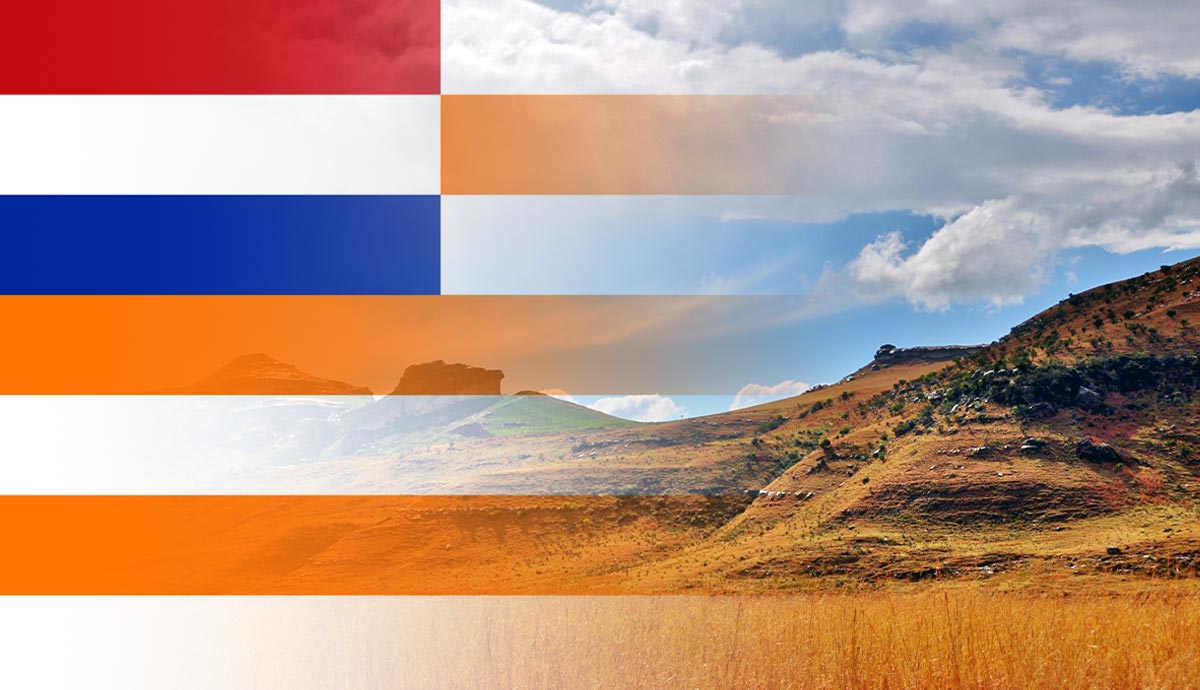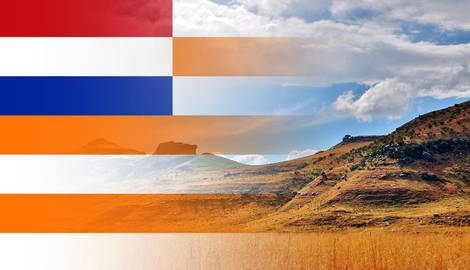
The Free State lies on the highest elevations of South Africa’s escarpment. As South Africa’s breadbasket, it is a land of farms and uninterrupted beauty that stretches across the highveld.
For most of its life, however, the Free State was known as the Orange Free State. With a storied and unique history as an independent country, a colony, and a province of South Africa, the Orange Free State exists as a vital part of South Africa’s history and, as the Free State, an essential part of South Africa’s future.
The Beginnings of the Orange Free State

At the end of the 18th century, European explorers were making their way inland from the Cape Colony and mapping out vast areas of the interior. Dutch explorer Robert Jacob Gordon was among the first to visit the lands that would become the Orange Free State.
The people who already lived there did so in sparse communities. Along with the few communities of Sotho people were the itinerant KhoiKhoi and the Bushmen (San). In the early 19th century, the first new settlers to make their home there were the Griqua, people of mixed-race descent who fled the Cape Colony and established themselves north of the Orange River. An already established mission station of the London Missionary Society became the new home of Griqua settlers and grew the mission station into a small town known as Philippolis.

In the early 19th century, the Cape Colony was taken from the Dutch by the British, who imposed their own laws. British rule angered the local Dutch colonials, who felt they were being disenfranchised. In 1824, a group of Trekboers, mainly of French Huguenot and German extraction, journeyed towards the interior and crossed the Orange River, seeking pasture for their flocks. Twelve years later, they were followed by the first Voortrekkers in a wave of colonization known as the Great Trek.
* Trekboers were individuals and families prior to 1830 who left the Cape Colony looking for a better life, while the Voortrekkers were unified by the common purpose of colonization and creating their own Boer state.
This was the time of the Mfecane (Scattering), a period of heightened conflict, generally thought to be the result of Zulu expansion. Tribes fled their settled homes, looking for new places to live, attacking other tribes, dispersing, or absorbing them. In the area that would become the Orange Free State, the Voortrekkers came into contact and conflict with many of these peoples, chief among them being the people led by Mzilikazi, a former general of Shaka Zulu, who had fled the Zulu Kingdom. Mzilikazi was a scourge on the northern parts of South Africa, laying waste to many parts of the land with scorched earth tactics. Although initially friendly with the Europeans, tensions broke down between him and the Voortrekkers, and conflict broke out, with the Voortrekkers eventually defeating Mzilikazi and thus removing a serious threat to colonization efforts.

After the defeat of Mzilikazi, the Voortrekkers established the town of Winburg on lands bought from Makwana, the chief of the Bataung tribe of Batswana. To the east, King Moshoeshoe of the Basotho had established lands that came under the protection of the British. These lands would eventually become the sovereign nation of Lesotho.
To the south, the settlement of Philippolis and its surrounding areas also came under British protection. Through these acts of protection, the British hoped to contain the Boers living north of the Orange River. By pressing for conflict between the Boers and the Griqua, the British formulated justification for claiming those living in the areas north of the Orange River as British subjects. Conflict ensued between the Boers in Philippolis, who accepted British rule, and the Griquas, who received preferential treatment from the British authorities. The Boers who lived there and accepted British rule felt disenfranchised and became hostile towards the Griqua people.
This was the pretext the British needed. They sent in troops to calm the conflict and claim all the land between the Vaal and the Orange Rivers. After this was done, they established Bloemfontein as the capital of this territory in defiance of the Boers, who still claimed ownership of the land and ran the territory from their own capital of Winburg.
After a brief struggle, culminating in a British victory at the Battle of Boomplaats, many Boers accepted British rule, while the leader of the Boers, along with the most ardent opposers to British rule, left the territory and went north across the Vaal River.
British Rule & British Abandonment

After the British established Bloemfontein, the region became known as the Orange River Sovereignty and was effectively a colony of the British Empire. Not wishing to engage with the prospect of future conflict within the sovereignty with the Boers, who wanted full independence with themselves as rulers, the British decided to abandon the colony.
In 1854, the independent republic of the Orange Free State was born, with Josias Philip Hoffman as its first president. A year later, he resigned and was replaced by Jacobus Nicolaas Boshoff.
Conflict With the Transvaal Republic and Basutoland

To the north of the Orange Free State, the son of Andries Pretorius, Marthinus, had founded the Transvaal Republic (also known as the South African Republic, not to be confused with the Republic of South Africa, which is the official name of the modern state of South Africa) in 1852. Marthinus Pretorius wanted the two republics to be confederated and made his desires known to the leaders of the Orange Free State. The Free Staters, however, refused, and Marthinus, with the support of future president Paul Kruger, assembled a small army and marched into the Orange Free State in 1857.
President Boshoff hastily created an army of his own in response. Such was the support that the Transvaalers quickly found themselves severely outnumbered and were forced to abandon their enterprise. Under a white flag, the two leaders recognized each other’s sovereignty.
Shortly afterward, conflict with the Basotho came to a head, and in a strange turn of events, Boshoff lost favor and resigned, while Marthinus Pretorius ended up being elected as the new president. Despite this development, he was still unable to realize his dream of a confederation between the two Boer Republics. He resigned in 1863 and moved back to the Transvaal. He was replaced by Johannes Brand.
Intermittent conflict with Basutoland caused weariness amongst the parties involved, and tired of the problem, the Orange Free State appealed to adventurers from all over South Africa to help them defeat Basutoland once and for all. This plea was successful, and with renewed support, the Free Staters managed to completely defeat Basutoland. This resulted in the annexation of a large part of Basotho territory.
Diamonds

In 1870, the discovery of diamonds attracted thousands of prospectors and diggers to the Griqua territory on the western edge of the Orange Free State. This area was under the control of Griqua chief Nicholas Waterboer, but it was also claimed by the Orange Free State, so when Nicholas Waterboer offered the administration of his territory to the British Empire, there was, naturally, some concern.
Some elements in the Orange Free State Volksraad (parliament) wished to go to war with Britain over the territorial claims, but calmer heads prevailed. Recognizing the tense situation, the British settled the matter by paying the Free State government £90,000 to relinquish their claim over the territory.
The Free Staters, however, did not have to suffer while watching their British neighbors reap the benefits of the diamond industry. Diamonds were also found within the Orange Free State borders at a place called Jagersfontein, and the diamond industry boomed across the region.
However, the discovery of gold in the Transvaal would not end so peacefully.
The Second Anglo-Boer War

The discovery of gold in the Transvaal prompted renewed interest from Britain in acquiring the profits of this industry. This meant a rise in tensions between the Transvaal Republic and Britain as both nations realized the value of this development.
Despite peaceful relations with Britain, the Orange Free State entered much closer relations with the Transvaal Republic, and in 1889, the two countries signed a pact of fealty, promising to aid each other in times of war.
Meanwhile, the British poured English-speaking immigrants into the Transvaal in an attempt to elect a pro-British government, but these attempts failed to produce the required results. In solidarity with their northern neighbor, the Orange Free State began to expel British subjects from its territory.
This caused a complete breakdown of relations between the two Boer republics on one side and the British on the other. On October 11, 1899, the Second Anglo-Boer War broke out, and the Orange Free State found itself in conflict with the most powerful empire on Earth.
Under the leadership of President Martinus Theunis Steyn, the Orange Free State fought valiantly, but the British finally won. Bloemfontein was occupied by the British on March 13, 1900, only a few months into the war, but the Free Staters continued the war, using guerilla tactics, along with their fellow Boers from the Transvaal Republic. These kommandos were eventually defeated after the British rounded up their families and placed them in concentration camps where it is estimated almost 30,000 Boer women and children died, along with tens of thousands of Black Africans who were put in separate camps.
The 20th Century in Orange Free State

In 1902, the Second Anglo-Boer War ended with a British victory, and the Orange Free State became the Orange River Colony. This lasted until 1910, when the Union of South Africa was declared, amalgamating most South African colonies into the independent country of the Union of South Africa.
The Orange Free State existed as one of South Africa’s four provinces for the next 84 years, with the same provincial dynamic remaining when South Africa declared itself a republic in 1961.
In 1994, as apartheid came to an end and a democratically elected government was sworn in, the map of South Africa changed. The provinces were split. Four provinces became nine, but the borders of the Orange Free State did not change. The only thing that was removed was “Orange.”
Today, the Free State has a population of around 3 million people, most of whom speak Sotho and/or Afrikaans. The provincial capital of Bloemfontein also serves as the judicial capital of South Africa (South Africa has three capital cities).

The Orange Free State, and its successor province, the Free State, are integral parts of South Africa that have helped shape the nation’s character. From mountains to plains to the beautiful gardens of Bloemfontein, this part of South Africa is an important place in the future of South Africa, as well as in its history books.










